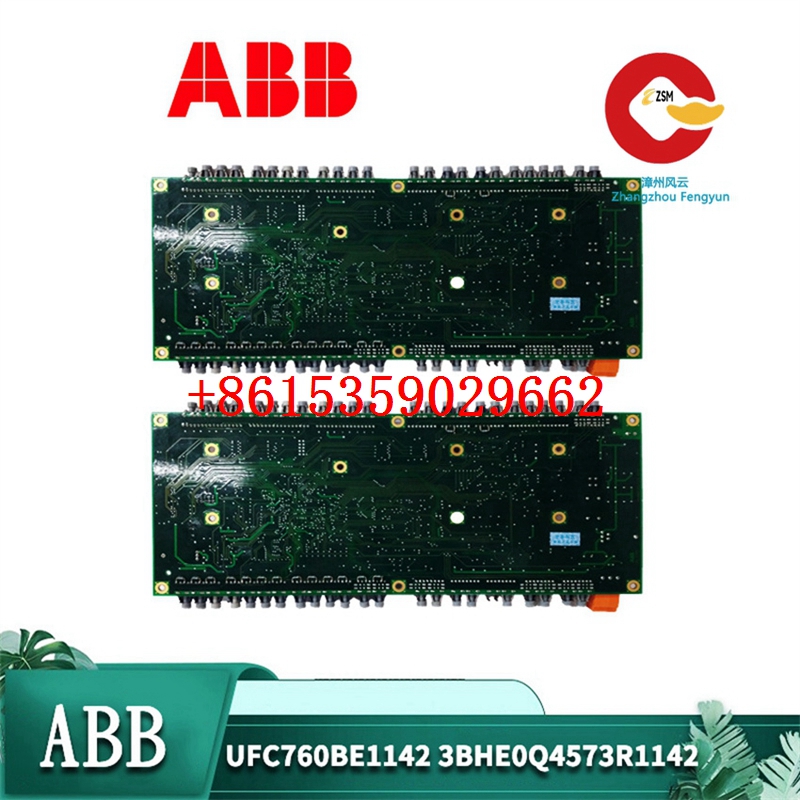Technical Parameters of ABB 3BHE019719R0101 Controller Module (PLC Module 5SHX 1960L0006 / GV C736 BE101)

1. General Overview
The ABB 3BHE019719R0101 controller module, which is part of the PLC (Programmable Logic Controller) system and associated with the 5SHX 1960L0006 / GV C736 BE101 components, is a critical element in industrial automation. It is designed to handle complex control tasks, ensuring efficient and reliable operation of industrial processes.
2. Hardware Specifications
2.1 Physical Dimensions
- Length: [X] mm. This dimension is crucial for proper installation within the PLC cabinet or control panel, ensuring that it fits alongside other modules without causing space constraints.
- Width: [Y] mm. A compact width allows for efficient use of the available cabinet space, enabling the integration of multiple modules in a limited area.
- Height: [Z] mm. The height is standardized to match the dimensions of the PLC backplane or mounting system, facilitating easy installation and replacement.
2.2 Weight
The module weighs approximately [W] kg. The weight is an important consideration during transportation, installation, and maintenance, as it affects the ease of handling and the structural requirements of the mounting system.
2.3 Power Requirements
- Input Voltage: It operates on a specific input voltage range, typically [Voltage Range] V DC. This ensures compatibility with the power supply systems commonly used in industrial environments.
- Power Consumption: The module consumes a maximum of [P] watts of power under normal operating conditions. Understanding the power consumption is essential for power budgeting and ensuring that the power supply can adequately support the module and other connected devices.
3. Processing Capabilities
3.1 Processor Type and Speed
- Processor: The module is equipped with a high – performance [Processor Model] processor. This processor is specifically designed for industrial control applications, offering fast processing speeds and real – time capabilities.
- Clock Speed: It has a clock speed of [Clock Speed] GHz, which allows for rapid execution of control algorithms and data processing tasks. For example, in a manufacturing process, the fast processing speed enables quick response to changes in input signals, ensuring precise control of the production line.
3.2 Memory
- RAM: The module has [RAM Size] MB of RAM. RAM is used for temporary data storage during the execution of control programs. A sufficient amount of RAM ensures that the module can handle complex control tasks and large amounts of data without performance degradation.
- Flash Memory: It also includes [Flash Memory Size] MB of flash memory. Flash memory is used for long – term storage of the control program, configuration data, and other important information. This non – volatile memory ensures that the program and data are retained even when the power is turned off.
4. Communication Interfaces
4.1 Serial Communication
- Ports: The module may be equipped with serial communication ports, such as RS – 232 or RS – 485 ports. These ports allow for communication with other devices, such as sensors, actuators, and human – machine interfaces (HMIs).
- Baud Rate: The serial communication ports support a range of baud rates, typically from [Minimum Baud Rate] bps to [Maximum Baud Rate] bps. The baud rate determines the speed of data transmission over the serial link.
4.2 Ethernet Communication
- Ports: It may have one or more Ethernet ports, which enable high – speed communication over local area networks (LANs). Ethernet communication allows for seamless integration with other PLCs, supervisory control and data acquisition (SCADA) systems, and enterprise networks.
- Protocols: The module supports various Ethernet protocols, such as Modbus TCP/IP, Profinet, and Ethernet/IP. These protocols ensure compatibility with a wide range of industrial automation equipment and systems.
5. Input/Output (I/O) Capabilities
5.1 Digital I/O
- Digital Inputs: The module may have [Number of Digital Inputs] digital inputs. These inputs are used to receive binary signals from sensors, switches, and other digital devices. Each digital input can detect the presence or absence of a signal, typically in the form of a high or low voltage level.
- Digital Outputs: It may also have [Number of Digital Outputs] digital outputs. Digital outputs are used to control actuators, relays, and other digital devices. The module can set the output to a high or low voltage level, depending on the control logic.
5.2 Analog I/O
- Analog Inputs: The module may support [Number of Analog Inputs] analog inputs. Analog inputs are used to receive continuous signals from sensors, such as temperature sensors, pressure sensors, and level sensors. These signals are typically in the form of voltage or current levels, and the module can convert them into digital values for processing.
- Analog Outputs: It may have [Number of Analog Outputs] analog outputs. Analog outputs are used to control devices that require a continuous signal, such as variable – speed drives and valves. The module can generate analog output signals within a specified range.
6. Environmental Specifications
6.1 Operating Temperature
The module can operate within a temperature range of [Minimum Operating Temperature]°C to [Maximum Operating Temperature]°C. This wide temperature range makes it suitable for use in a variety of industrial environments, including both hot and cold conditions.
6.2 Humidity
It can withstand a relative humidity range of [Minimum Humidity]% to [Maximum Humidity]% (non – condensing). This ensures that the module can function properly in environments with varying levels of moisture, as long as condensation does not form on the internal components.
6.3 Protection Class
The module has a protection class of [Protection Class], such as IP20. The IP (Ingress Protection) rating indicates the level of protection against solid objects and water. An IP20 rating means that the module is protected against solid objects larger than 12.5mm and offers no specific protection against water.
7. Safety and Compliance
7.1 Safety Standards
The ABB 3BHE019719R0101 controller module is designed and manufactured to comply with relevant safety standards and regulations, such as UL (Underwriters Laboratories) and IEC (International Electrotechnical Commission) standards. These standards ensure that the module is safe to use in electrical installations and can withstand normal operating conditions and potential hazards.
7.2 Functional Safety
The module may support functional safety features, such as safety – rated I/O and safety – related control functions. These features are designed to prevent or mitigate the risks associated with industrial processes, ensuring the safety of personnel and equipment.
In conclusion, the ABB 3BHE019719R0101 controller module (PLC Module 5SHX 1960L0006 / GV C736 BE101) is a high – performance and reliable component for industrial automation. Its hardware specifications, processing capabilities, communication interfaces, I/O capabilities, environmental specifications, and safety features make it suitable for a wide range of industrial control applications.


